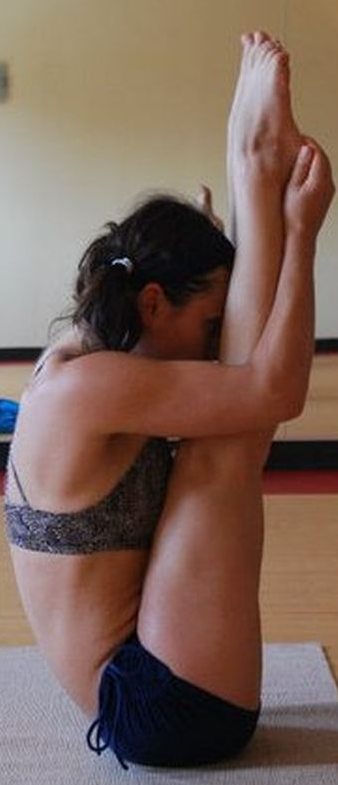Source
- Alexander Yanai Volume 4, Part A
- Reel 12, Track 2, Lesson 5
Synopsis
- Maybe there are two related parts:
Folding the upper body closer to the lower: Lying on the back, holding one leg (or both legs) and folding the ends… so that the shoulder (and head) rise toward the raised feet (see image, at right)
- Swinging the free leg to come to sitting (the other leg is held close to the body)
- Involving (engaging, waking up) the back: inviting the back to lengthen with arms to feet, yet, when coming to sitting the need to change the shape to more of an arch (e.g. belly forward)
- Implicitly, the student begins to learn how to move the center of balance forward & back. This is accomplished only by releasing the habitual tonus in the low back and pelvic region.
- The lesson is incomplete.
Lesson Outline
- Highly condensed outline of key movements
Position: Supine position on the back, the left knee bent and the left foot standing on the floor, the right leg extended and lifted into the air, the right foot towards the ceiling, the right hand behind the right knee, the face turned to the right, the left hand behind the right ear.
- Steps 1 &2: Move the right knee towards the left elbow… (“join the limbs up high…“) (“…without pressing the floor. Do not push the floor; only lift the parts from the floor”). Feet are parallel to ceiling (not extended in the photo)
- Steps 3 & 4: similar to 1& 2 but add: extend the opposite leg on the floor (“attach (glue) the knee to the floor“)
- Steps 5, 6 : Raise one leg; with both hands, climb up the leg… to the heel. Repeat on other leg.
- Steps 7, 8, 9: Lift both legs, spread and climb up both. Then climb one; then the other.
- Steps 10 & 11. Two legs in the air, climb one leg, then swing the free leg… until the body will sit. (“It is actually possible to leave the ankle on the floor, bend the knee and and then straighten it. That is all that is necessary.“)
- Step 12. As with 10 & 11 but with L hand behind R ear (facing right) R hand behind R leg extended in air so head & knee are closer). Keeping the folded position, swing the L leg… to sitting.
- The recording/transcripts end here.
- Logical next step (13) is the opposite of 12.
- Additional ideas include:
- swinging both feet above head to toes touch ground. Then swinging to sitting. Maybe alternating one leg and the other.
- Come to sitting through the middle, attending to the extending of the back and lengthening the legs
Focus of Moshe’s Teaching
- focus or key principles that are made explicit in the teaching
Related ATMs
- Preparatory lessons, AY 168
- See Also Theme Yoga
- 5-winds-kata
Climbing along the legs:
Resources
Share Your Insights (ideas, principles, strategies, experiences, …)
- Comments from some students:
- Some find starting each movement with imagining
- For some, a delightful idea of climbing (up the legs)
- The possibility of shifting the centre of balance to different places in the pelvis
- Rather than pushing into the ground, allowing weight to be distributed through those parts that are in contact with the ground (clarifying ground forces)
- The idea of the snakelike flowing from extending to flexing: consider how one swings on a swing. pumping & swinging (undulation: sense sitbones, pelvis, low back). This might be an interesting variation to help that sensation.
- Add your thoughts about the lesson here.
- Differing viewpoints are welcome and desired!
Disclaimer: This site is for sharing information about Feldenkrais® Awareness Through Movement® lessons. The information included on this site is for educational purposes only. Nothing on Feldy Notebook should be construed as an attempt to offer medical advice or treatment. All contributions to this website are licensed under the Creative Commons Attribution Share-Alike 3.0 License. Do not add any copyrighted information to this website. Feldy Notebook is sponsored by Kinetic Inquiry.
 Folding the upper body closer to the lower: Lying on the back, holding one leg (or both legs) and folding the ends… so that the shoulder (and head) rise toward the raised feet (see image, at right)
Folding the upper body closer to the lower: Lying on the back, holding one leg (or both legs) and folding the ends… so that the shoulder (and head) rise toward the raised feet (see image, at right)